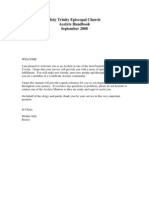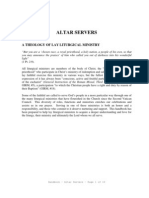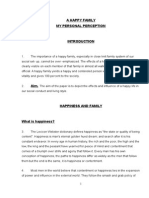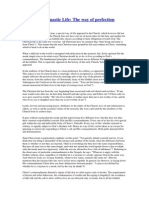0 ratings0% found this document useful (0 votes)
5 viewsMedieval Monks & Nuns
Medieval Monks & Nuns
Uploaded by
jamesryan831Medieval monks and nuns provided important services like caring for the sick, teaching literacy, and offering charity and shelter to people in need. They lived highly structured lives centered around prayer, work, and following strict rules. Monks and nuns lived and worked together in monasteries and convents, with buildings like churches, cloisters, dormitories, and infirmaries arranged around a central garden. Their architecture evolved over time from the Romanesque to Gothic styles.
Copyright:
© All Rights Reserved
Available Formats
Download as PPTX, PDF, TXT or read online from Scribd
Medieval Monks & Nuns
Medieval Monks & Nuns
Uploaded by
jamesryan8310 ratings0% found this document useful (0 votes)
5 views9 pagesMedieval monks and nuns provided important services like caring for the sick, teaching literacy, and offering charity and shelter to people in need. They lived highly structured lives centered around prayer, work, and following strict rules. Monks and nuns lived and worked together in monasteries and convents, with buildings like churches, cloisters, dormitories, and infirmaries arranged around a central garden. Their architecture evolved over time from the Romanesque to Gothic styles.
Copyright
© © All Rights Reserved
Available Formats
PPTX, PDF, TXT or read online from Scribd
Share this document
Did you find this document useful?
Is this content inappropriate?
Medieval monks and nuns provided important services like caring for the sick, teaching literacy, and offering charity and shelter to people in need. They lived highly structured lives centered around prayer, work, and following strict rules. Monks and nuns lived and worked together in monasteries and convents, with buildings like churches, cloisters, dormitories, and infirmaries arranged around a central garden. Their architecture evolved over time from the Romanesque to Gothic styles.
Copyright:
© All Rights Reserved
Available Formats
Download as PPTX, PDF, TXT or read online from Scribd
Download as pptx, pdf, or txt
0 ratings0% found this document useful (0 votes)
5 views9 pagesMedieval Monks & Nuns
Medieval Monks & Nuns
Uploaded by
jamesryan831Medieval monks and nuns provided important services like caring for the sick, teaching literacy, and offering charity and shelter to people in need. They lived highly structured lives centered around prayer, work, and following strict rules. Monks and nuns lived and worked together in monasteries and convents, with buildings like churches, cloisters, dormitories, and infirmaries arranged around a central garden. Their architecture evolved over time from the Romanesque to Gothic styles.
Copyright:
© All Rights Reserved
Available Formats
Download as PPTX, PDF, TXT or read online from Scribd
Download as pptx, pdf, or txt
You are on page 1of 9
Medieval
Monks & Nuns
What are we going to take a
look at?
- The purpose of monks
and nuns
- Becoming a monk or nun
- Daily Life
- Monasteries
- Church architecture
The Purpose of
Monks and Nuns
• Monks and nuns did much to help and
improve medieval society.
• They tended to the sick.
• They taught people to read and write.
• They provided charity to the poor.
• They provided accommodation to people
travelling.
• They provided sanctuary (place of safety)
to people in danger of being attacked or
arrested.
• Q1: Does the work of monks and nuns
remind you of any modern institutions or
organisations?
Becoming a Monk or
Nun
• Anyone who became a monk or nun first
had to serve as a novice (think of it like an
apprentice craftsman).
• They would help with the work of the
monastery (monks) or convent (nuns) and
learn the Rule of St. Benedict.
• The head abbot or abbess would decide if
the novice became a monk or nun.
• New monks and nuns took three vows
(promises): 1. Poverty – no personal
possessions, 2. Chastity – never marry or
have kids and 3. Obedience – obey their
abbot or abbess
• New monks had their heads shaved in the
Daily Life
• According to the Rule of St. Benedict,
monk/nun life was organised around prayer
and work.
• Being inactive (or idle) was seen as a pathway
to living a bad or sinful life which is why
monks/nuns kept themselves so busy.
• Prayer was held seven times a day in the
church.
• Monks/nuns did various jobs in their
monasteries/convents: farming, teaching,
creating manuscripts, embroidery, providing
medical aid and charity to locals.
• Q2: Do you admire the work of monks and
nuns or do you wonder why they bothered?
• Q3: Could you ever imagine yourself as a nun?
Why? Why not?
Some did lose the run of themselves.
Monasteries
• The church was the main
building and was used for
mass.
• The cloister was a covered
walkway enclosed by a
garden.
• Manuscripts were worked
on in the scriptorium.
• Sick people were treated in
the infirmary.
• Meals were had in the
refectory.
• The dormitory provided
sleeping quarters.
Do you recognise this cloister?
Church
Architecture
• Over the course of the
Middle Ages, the style of
church architecture changed
from Romanesque to
Gothic.
• The features of Gothic style
included rose windows,
lancet windows, pointed
windows, spires and
buttresses.
• Q4: Do any of you recognise
this famous landmark?
• Q5: Do you prefer Gothic or
Romanesque style and why?
A Romanesque Abbey
You might also like
- Oxford Assess and Progress: Situational Judgement Test 2/eDocument5 pagesOxford Assess and Progress: Situational Judgement Test 2/eansatNo ratings yet
- BOOK NOTES-2008-06-The Celtic Way of EvangelismDocument9 pagesBOOK NOTES-2008-06-The Celtic Way of EvangelismJohn_Baw100% (4)
- The Domestic MonasteryDocument1 pageThe Domestic MonasteryjosetteuNo ratings yet
- Parting Glass AcapellaDocument7 pagesParting Glass AcapellaErik Joshua ClackNo ratings yet
- Altar Server SeminarDocument63 pagesAltar Server SeminarGeevee Naganag Ventula100% (2)
- History of Altar Server, Founder of KnightsDocument17 pagesHistory of Altar Server, Founder of Knightspaul_fuentes_4No ratings yet
- Acolyte Handbook HT Episcopal ChurchDocument14 pagesAcolyte Handbook HT Episcopal ChurchLarry Jr LiboonNo ratings yet
- First Century ChurchDocument15 pagesFirst Century ChurchkckamacNo ratings yet
- Interpretation of Built of Living StonesDocument13 pagesInterpretation of Built of Living StonesChrisWhittleNo ratings yet
- Monastery LifeDocument4 pagesMonastery Lifeapi-439280190No ratings yet
- Medieval MonkDocument1 pageMedieval MonkMarthaNo ratings yet
- Monastic LifeDocument14 pagesMonastic LifePraneet NagdevNo ratings yet
- MonasticismDocument32 pagesMonasticismapi-32558781No ratings yet
- Lesson 10Document11 pagesLesson 10iugwuanyi2No ratings yet
- The Church in The Middle AgesDocument15 pagesThe Church in The Middle Ages김나연No ratings yet
- Church History 1: Middle Ages MonasticismDocument27 pagesChurch History 1: Middle Ages MonasticismBebe TimeNo ratings yet
- History of Monasticism 2Document37 pagesHistory of Monasticism 2Caitlin Anne OlayvarNo ratings yet
- Consecrated Life: History in The Church and in The United States TodayDocument58 pagesConsecrated Life: History in The Church and in The United States TodayHarvey100% (3)
- The Permanent Diaconate: Mr. Pablo Cuadra Religion ClassDocument20 pagesThe Permanent Diaconate: Mr. Pablo Cuadra Religion ClassPablo CuadraNo ratings yet
- 13.religion in BritainDocument21 pages13.religion in BritainHo PhanNo ratings yet
- Monastic LifeDocument2 pagesMonastic Lifetadious yirdawNo ratings yet
- Christianity Gcse: Unit 1: Part A Practices NameDocument36 pagesChristianity Gcse: Unit 1: Part A Practices NameCHEEKOTI VIVEKNo ratings yet
- III - Issues Affecting Church's LifeDocument29 pagesIII - Issues Affecting Church's LifeJelyne santos100% (1)
- Sacred Spaces: Mr. Pablo Cuadra Religion ClassDocument20 pagesSacred Spaces: Mr. Pablo Cuadra Religion ClassPablo CuadraNo ratings yet
- Monks and Nuns of The Middle AgesDocument2 pagesMonks and Nuns of The Middle AgesHarlene Arabia100% (1)
- Monks and Nuns of The Middle AgesDocument2 pagesMonks and Nuns of The Middle Agesonyango HILLARYNo ratings yet
- Pope Kyril Los Vi by R IbrahimDocument24 pagesPope Kyril Los Vi by R IbrahimDanayit TsegayeNo ratings yet
- History Project - Grade 11-Term 1 (Group 8)Document9 pagesHistory Project - Grade 11-Term 1 (Group 8)Shaula BhushanNo ratings yet
- Age of Faith Outline Notes and Paragraph PromptDocument6 pagesAge of Faith Outline Notes and Paragraph PromptBrian Roberts100% (1)
- Deacons - Extract - Church Officers Handbook 2024 - TPMDDocument2 pagesDeacons - Extract - Church Officers Handbook 2024 - TPMDmuzovugNo ratings yet
- Changes in MonasticismDocument5 pagesChanges in MonasticismHugo VillavicencioNo ratings yet
- The Medieval ChurchDocument5 pagesThe Medieval ChurchStela Zarea100% (1)
- Unit 2, Assi 1Document2 pagesUnit 2, Assi 1Lucy WangNo ratings yet
- Power of The Church 23 24Document26 pagesPower of The Church 23 24api-665061381No ratings yet
- Conversion of Mission To ParishDocument10 pagesConversion of Mission To ParishJose FalogmeNo ratings yet
- The Prayer RopeDocument24 pagesThe Prayer RopePablo Cuadra100% (2)
- Lesson Plans For Grades 7 8Document2 pagesLesson Plans For Grades 7 8Nerona Hannah KateNo ratings yet
- Wisdom from the Monastery: The Rule of St.Benedict for Everyday LifeFrom EverandWisdom from the Monastery: The Rule of St.Benedict for Everyday LifeNo ratings yet
- Traditional Methods For Church Planting 1 EgnlishDocument1 pageTraditional Methods For Church Planting 1 EgnlishAntonio GnzNo ratings yet
- Sacrament of Holy OrderDocument24 pagesSacrament of Holy OrderHaziaaaakNo ratings yet
- How Do Friars Differ From Priests - QuoraDocument1 pageHow Do Friars Differ From Priests - QuoraGrace Andrea FelixNo ratings yet
- Ministry RolesDocument55 pagesMinistry RolesAnthony FarenNo ratings yet
- Unit Four: The Church Is TeacherDocument49 pagesUnit Four: The Church Is TeachercollinmandersonNo ratings yet
- Altar Servers GuideDocument11 pagesAltar Servers GuideJan Pierre Pizarro0% (1)
- Chantry Priests' Houses and Other Medieval LodgingsDocument43 pagesChantry Priests' Houses and Other Medieval Lodgingsvargus12No ratings yet
- The Church of EnglandDocument1 pageThe Church of EnglandGabriela PacoNo ratings yet
- 2022 Altar Server GuideDocument47 pages2022 Altar Server Guideshena marie requintoNo ratings yet
- Pre HistoricDocument1 pagePre HistoricAlcain, Mary Cris R.No ratings yet
- Life in A Medieval MonasteryDocument10 pagesLife in A Medieval Monasteryapi-255871782No ratings yet
- People in History - A Monk in Early Christian IrelandDocument1 pagePeople in History - A Monk in Early Christian Irelandrupart duckington100% (1)
- Grade 11 World Religions HRT 3M1: Please Keep Camera and Mic OffDocument15 pagesGrade 11 World Religions HRT 3M1: Please Keep Camera and Mic OffLuca FerrandiniNo ratings yet
- Monk People in HistoryDocument1 pageMonk People in Historyapi-268302006No ratings yet
- Unit 3 RSDocument2 pagesUnit 3 RSChristine MoniqueNo ratings yet
- Altar Server HandbookDocument44 pagesAltar Server Handbookrixky709No ratings yet
- Ecw Short OrientationDocument69 pagesEcw Short OrientationJohny Sarangay100% (3)
- Religious, Diocesan and Contemplative LifeDocument39 pagesReligious, Diocesan and Contemplative LifeGabby MaravillaNo ratings yet
- History, Philosophy and Foundation of Chaplaincy-EditedDocument28 pagesHistory, Philosophy and Foundation of Chaplaincy-EditedDaniel TomaNo ratings yet
- Parish Profile ST Mary Orton WatervilleDocument13 pagesParish Profile ST Mary Orton WatervilleLiam ChambersNo ratings yet
- OUR LADY OF ROSARY RUKUbiographyDocument4 pagesOUR LADY OF ROSARY RUKUbiographyPAUL NJUGUNANo ratings yet
- Chapter Nine: The Ministry and Life of Bishops, Priests, and DeaconsDocument16 pagesChapter Nine: The Ministry and Life of Bishops, Priests, and DeaconscollinmandersonNo ratings yet
- The Cold WarDocument26 pagesThe Cold Warjamesryan831No ratings yet
- History Test - 1798 RebellionDocument6 pagesHistory Test - 1798 Rebellionjamesryan831No ratings yet
- History Test - The French Revolution (PDF)Document6 pagesHistory Test - The French Revolution (PDF)jamesryan831No ratings yet
- Monasteries - Early Chritian IrelandDocument7 pagesMonasteries - Early Chritian Irelandjamesryan831No ratings yet
- Women of The RenaissanceDocument20 pagesWomen of The Renaissancejamesryan831No ratings yet
- History Test - Communist Russia (PDF)Document6 pagesHistory Test - Communist Russia (PDF)jamesryan831No ratings yet
- Gutenberg and ShakespeareDocument21 pagesGutenberg and Shakespearejamesryan831No ratings yet
- Consequences of The ReformationDocument16 pagesConsequences of The Reformationjamesryan831No ratings yet
- Aztecs and IncasDocument14 pagesAztecs and Incasjamesryan831No ratings yet
- Intro To Early Christian IrelandDocument7 pagesIntro To Early Christian Irelandjamesryan831No ratings yet
- Medieval KnightsDocument8 pagesMedieval Knightsjamesryan831No ratings yet
- Ramadan and IftarDocument2 pagesRamadan and IftarKimberly Descuatan100% (1)
- A Happy Family My Personal PerceptionDocument9 pagesA Happy Family My Personal Perceptionjaydee_atc5814No ratings yet
- A Z of Simple Living BookDocument68 pagesA Z of Simple Living Bookdrsubramanian100% (4)
- Sustainability and Human Values: Lecture Notes 2Document4 pagesSustainability and Human Values: Lecture Notes 2Princess NobleNo ratings yet
- How To Live Off The Grid, Disappear...Document298 pagesHow To Live Off The Grid, Disappear...Nathan GuillemetteNo ratings yet
- De Thi Writing Tong HopDocument8 pagesDe Thi Writing Tong HoplethibinhnguyenNo ratings yet
- Jainism Vis A Vis Brahmanism 269035 STDDocument47 pagesJainism Vis A Vis Brahmanism 269035 STDzillionpplNo ratings yet
- DLP - Genabe J Cherry MaeDocument17 pagesDLP - Genabe J Cherry MaeCherry Mae Valdez-GenabeNo ratings yet
- Church History 1: Middle Ages MonasticismDocument27 pagesChurch History 1: Middle Ages MonasticismBebe TimeNo ratings yet
- Politica 2022Document2 pagesPolitica 2022mstnargishbanuNo ratings yet
- Delatte On VocationDocument3 pagesDelatte On VocationSancrucensisNo ratings yet
- From Monastery To HospitalDocument16 pagesFrom Monastery To HospitalFrancesco ManiscalcoNo ratings yet
- Philocalia 2Document253 pagesPhilocalia 2George DibNo ratings yet
- New Order AmishDocument3 pagesNew Order Amishjoshua33No ratings yet
- Anita Goswami - Hermit To Cenobitic - A Study in Early Christian MonasticismDocument8 pagesAnita Goswami - Hermit To Cenobitic - A Study in Early Christian MonasticismTiberiu OprisNo ratings yet
- Simplicity and SuccessDocument202 pagesSimplicity and Successraj16785100% (4)
- Mod 4 Les 2Document4 pagesMod 4 Les 2Aea YangNo ratings yet
- Lenten PromisesDocument1 pageLenten PromisessapsygoNo ratings yet
- Basic History TricksDocument7 pagesBasic History TricksAmit Shukla100% (1)
- English 2023 CombinedDocument18 pagesEnglish 2023 Combinedhamzaarain3210No ratings yet
- 2018 School Inspections SpreadsheetDocument168 pages2018 School Inspections SpreadsheetMaritza NunezNo ratings yet
- PH 3 Bahasa Inggris Kelas Xi 2021 (Jawaban)Document25 pagesPH 3 Bahasa Inggris Kelas Xi 2021 (Jawaban)rusandiNo ratings yet
- Monastic LifeDocument2 pagesMonastic Lifetadious yirdawNo ratings yet
- Fashion Consumption Using Minimalism Exploring The 2023 Journal of RetailinDocument11 pagesFashion Consumption Using Minimalism Exploring The 2023 Journal of RetailinBaim HasanNo ratings yet
- The Monastic LifeDocument7 pagesThe Monastic Lifesihastriaputnei9630No ratings yet
- The Red MonasteryDocument6 pagesThe Red MonasteryNabil RoufailNo ratings yet
- Peyer2016 (Voluntary Simplifiers)Document7 pagesPeyer2016 (Voluntary Simplifiers)alaamohsenNo ratings yet


































































































